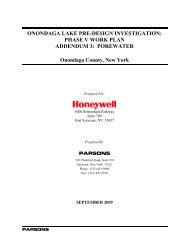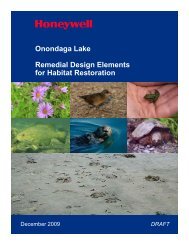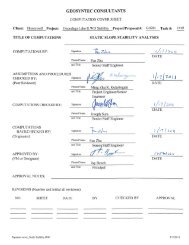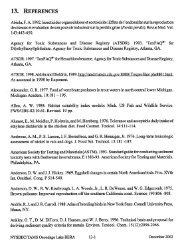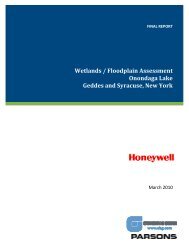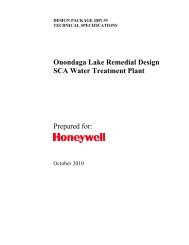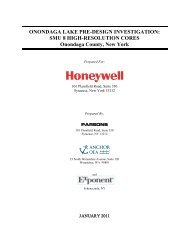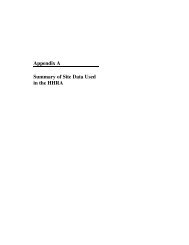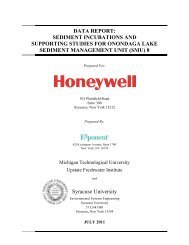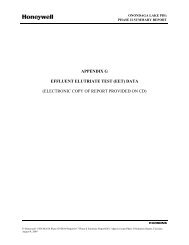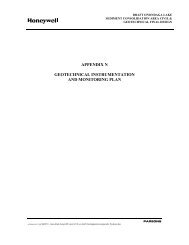Phase 1B Underwater Archaeological Report for the Onondaga ...
Phase 1B Underwater Archaeological Report for the Onondaga ...
Phase 1B Underwater Archaeological Report for the Onondaga ...
Create successful ePaper yourself
Turn your PDF publications into a flip-book with our unique Google optimized e-Paper software.
FINAL<br />
<strong>Phase</strong> IB <strong>Underwater</strong> <strong>Archaeological</strong> Resources <strong>Report</strong> <strong>for</strong> <strong>Onondaga</strong> Lake Superfund Site<br />
Anomaly 20: Rock Scow<br />
Anomaly 20 Summary Table<br />
Anomaly Identification Wooden Rock Scow; NY Site Number 06740.012298<br />
Remedial Impact<br />
None<br />
NRHP Eligibility<br />
Eligible, Criteria C and D<br />
Recommendation<br />
Anomaly Dataset<br />
Side Scan (2005) 501<br />
Magnetometer (2005) 170, 178, 1066, 1065<br />
Side Scan (2010) 6/2/10<br />
Sector Scan (2010) 6/4/10<br />
ROV (2010) 6/11/10<br />
Diver Observations No<br />
Diver Videography<br />
No<br />
Maps/Charts<br />
No<br />
Aerial Imagery<br />
No<br />
Historic Accounts<br />
No<br />
Research Results<br />
A20 is a well-preserved early twentieth century wooden rock scow resting in approximately 20 feet<br />
(6.1m) of water on a hard bottom, with nearly <strong>the</strong> entire structure exposed above <strong>the</strong> lake bed. The site<br />
was examined with side scan sonar, sector scan sonar and ROV (Figure 108 and Figure 109). The<br />
archaeological data, although not conclusive, suggests that A20 is a rock scow. This once commonplace<br />
vessel type was used to transport stone and sand throughout <strong>the</strong> canal system and beyond (Figure 110).<br />
Rock scows were similar to flat deck scows; however, <strong>the</strong> vessels were equipped with high-deck end<br />
bulkheads at <strong>the</strong> bow and stern, and lower longitudinal bulkheads along <strong>the</strong> side of <strong>the</strong> hull. The<br />
bulkheads served to retain <strong>the</strong> deck-loaded cargo.<br />
A20 is 91½ feet (27.89m) long by 32½ feet (9.91m) wide, with most of its principal members still extant<br />
including <strong>the</strong> sides, ends, deck beams, hanging and standing knees, stringers, and framing. The vessel<br />
also retains some decking and <strong>the</strong> high deck-end bulkheads and longitudinal retaining bulkheads are<br />
displaced, but lying near or on <strong>the</strong> wreck. The hull is characterized by vertical edge-fastened sides and<br />
scow ends. The ends are framed with rake timbers. Most of A20’s deck beams are still in place with<br />
most still retaining vertical knees at <strong>the</strong> outboard ends <strong>for</strong> longitudinal retaining bulkheads. The high<br />
deck-end bulkheads are believed to be lying against <strong>the</strong> side of <strong>the</strong> hull at <strong>the</strong> scow’s eastern end and on<br />
<strong>the</strong> bottom adjacent to <strong>the</strong> western end (Figure 111). A20 has a small section of intact decking<br />
amidships along its sou<strong>the</strong>rn side. Overall <strong>the</strong> site retains approximately 90% of <strong>the</strong> vessel’s original<br />
structure.<br />
The circumstances of A20’s loss are unclear. Unlike <strong>the</strong> vessels in <strong>the</strong> Syracuse Maritime Historic<br />
District, which circumstantial evidence strongly suggests were abandoned, A20’s location north of<br />
Lakeview Point does not provide any such compelling evidence. Scuttled vessels tend to be let go at <strong>the</strong><br />
nearest possible point where <strong>the</strong>y can be left without any hindrance to navigation. A20’s mid-lake<br />
location suggests <strong>the</strong> possibility that <strong>the</strong> scow was lost in distress. Additional archaeological study<br />
would be needed to clarify <strong>the</strong> circumstances of its loss.<br />
161



